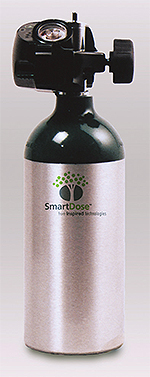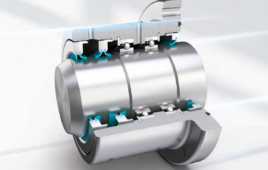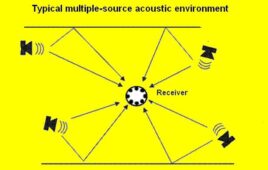Long-term oxygen therapy is the only intervention known to increase life expectancy for the more than 30 million chronic obstructive pulmonary disease sufferers in the U.S. Providing people with the correct amount of oxygen is critical to preventing blood oxygen levels from dropping below normal and stressing vital organs and limiting ambulation.

The unit uses a Festo
Piezovalve to help preserve
battery life.
Historically, oxygen conservers – devices that deliver oxygen when someone inhales – were designed to deliver a fixed-minute or fixed-pulse dose of oxygen per breath. Since most users are ill, making the manual adjustments that are required to increase or decrease the oxygen flow of these units can be difficult. Also, these oxygen conservers do not automatically monitor breathing and adjust oxygen dosage based on the patient’s activity level.
Rick Kocinski, executive vice-president of evoMedical Solutions, set a goal to design a conserver that could monitor a person’s exertion level through breathing patterns, and automatically adjust the oxygen supply to meet an individual’s needs, which would also make the device more efficient and use less oxygen.
The initial design was a unit that used a unique microprocessor and pressure transducer to monitor oxygen requirements for every breath. Sophisticated algorithms instructed a multi-solenoid valve mechanism to deliver the oxygen dose required by the user at any activity level. However, because the solenoid valves demand relatively large current, the unit’s rechargeable batteries lasted for only about four days. To eliminate frequent battery replacement or battery chargers, Kocinski sought an option that would provide the advantages of an electric unit yet eliminate high current load on the batteries.
“When we integrated the Festo Piezovalve into our design, we went from valve current demand of 90% down to a valve current of less than 3%,” said Kocinski. “That enabled an even greater battery life extension if we were able to cut down on the processor, transducer, and instrumentation electrical overhead.
“Rather than invest in low power chip sets, which would have required us to do recoding and change the firmware and hardware design, we did a lot of things to manage power in the circuits,” added Kocinski. “During the design stage, we went from three or four days on a set of standard AA alkaline batteries to 1,300 hours, which is approximately one year’s worth of usage.”

The core of the Festo Piezovalve is a carbon ceramic gap bender that is self- compensating for temperature and can control flows up to 20 lpm. The bender is packaged in a 7 mm-thick body with integrated header pins for easy integration. The valve has three ports and can be used either as a pair of 2/2 valves or a 3-way valve with a closed center port.
Unlike conventional solenoid valves that require constant power to remain open, piezo valves remain in position after being charged in a manner similar to a small capacitor. This gives them the properties of a latching valve, even when used in partially opened proportional applications. In addition, the Piezovalve requires less energy to open – about 1 millijoule (mJ), compared to the 5 mJ that a low power 1 W solenoid requires.
Electrical design plays a large part in the performance of the Piezovalve. Its proportional characteristic allows you to slowly open or close the valve to reduce noise or to soften gas delivery. Its dynamic nature works well in closed loop controls.
Inspired Technologies
www.inspiredtechnologiesinc.com
Festo
www.festo.com/cms/en-us_us
::Design World::
Filed Under: Pneumatic equipment + components, Valves, Medical-device manufacture, Energy management + harvesting





Tell Us What You Think!